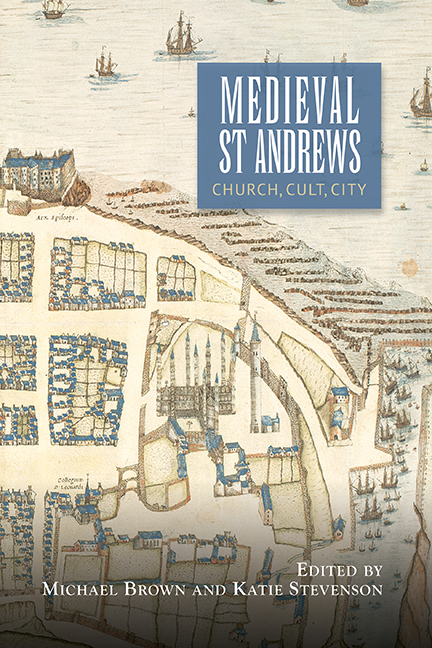Book contents
- Frontmatter
- Dedication
- Contents
- List of Illustrations, Charts and Tables
- Contributors
- Abbreviations
- 1 ‘Ancient Magnificence’: St Andrews in the Middle Ages: An Introduction
- 2 From Cinrigh Monai to Civitas Sancti Andree: A Star is Born
- 3 The Idea of St Andrews as the Second Rome Made Manifest
- 4 The Medieval Ecclesiastical Architecture of St Andrews as a Channel for the Introduction of New Ideas
- 5 When the Miracles Ceased: Shrine and Cult Management at St Andrews and Scottish Cathedrals in the Later Middle Ages
- 6 Religion, Ritual and the Rhythm of the Year in Later Medieval St Andrews
- 7 Living in the Late Medieval Town of St Andrews
- 8 The Burgh of St Andrews and its Inhabitants before the Wars of Independence
- 9 The Archaeology of Medieval St Andrews
- 10 Prelates, Citizens and Landed Folk: St Andrews as a Centre of Lordship in the Late Middle Ages
- 11 Augmenting Rentals: The Expansion of Church Property in St Andrews, c. 1400–1560
- 12 The Prehistory of the University of St Andrews
- 13 University, City and Society
- 14 The Medieval Maces of the University of St Andrews
- 15 Heresy, Inquisition and Late Medieval St Andrews
- Appendix 1 The St Andrews Foundation Account
- Appendix 2 The Augustinian' Account
- Appendix 3 The Boar' Raik
- Appendix 4 University of St Andrews Library, UYSL 110/6/4
- Index
- Miscellaneous Endmatter
15 - Heresy, Inquisition and Late Medieval St Andrews
Published online by Cambridge University Press: 28 April 2017
- Frontmatter
- Dedication
- Contents
- List of Illustrations, Charts and Tables
- Contributors
- Abbreviations
- 1 ‘Ancient Magnificence’: St Andrews in the Middle Ages: An Introduction
- 2 From Cinrigh Monai to Civitas Sancti Andree: A Star is Born
- 3 The Idea of St Andrews as the Second Rome Made Manifest
- 4 The Medieval Ecclesiastical Architecture of St Andrews as a Channel for the Introduction of New Ideas
- 5 When the Miracles Ceased: Shrine and Cult Management at St Andrews and Scottish Cathedrals in the Later Middle Ages
- 6 Religion, Ritual and the Rhythm of the Year in Later Medieval St Andrews
- 7 Living in the Late Medieval Town of St Andrews
- 8 The Burgh of St Andrews and its Inhabitants before the Wars of Independence
- 9 The Archaeology of Medieval St Andrews
- 10 Prelates, Citizens and Landed Folk: St Andrews as a Centre of Lordship in the Late Middle Ages
- 11 Augmenting Rentals: The Expansion of Church Property in St Andrews, c. 1400–1560
- 12 The Prehistory of the University of St Andrews
- 13 University, City and Society
- 14 The Medieval Maces of the University of St Andrews
- 15 Heresy, Inquisition and Late Medieval St Andrews
- Appendix 1 The St Andrews Foundation Account
- Appendix 2 The Augustinian' Account
- Appendix 3 The Boar' Raik
- Appendix 4 University of St Andrews Library, UYSL 110/6/4
- Index
- Miscellaneous Endmatter
Summary
BY the late Middle Ages St Andrews was a major ecclesiastical centre and was home to an associated intellectual community that was to become the foundation of a university. Such a vibrant mix of scholars and clerics made St Andrews an obvious destination for heretical and heterodox thinkers who wished to engage with intellectual circles in the town on matters of doctrine and the principles of Church authority. Evidence indicates that the principal heresies of the late Middle Ages were preached in St Andrews and the eradication and avoidance of heretical thought played a considerable role in early university life. To combat the inherent attraction of St Andrews for those who sought to question orthodoxy, there quickly emerged formal channels of inquisition, with St Andrews providing the structural focal point. Indeed, the rector of the university, Laurence of Lindores, was appointed as first Papal Inquisitor of Heretical Pravity in Scotland. Lindores tried many cases of heresy in both the town and diocese of St Andrews, several of which resulted in public executions but the vast majority of which did not. This essay will explore the links between the university, the Church and the detection of heresy in the town and the diocese of St Andrews.
The closing decades of the fourteenth century and the first of the fifteenth century saw considerable tensions within the late medieval Church. Pluralism and the abuse of benefices were rife, the protracted Great Schism drove the Church into near-terminal disarray, and European alliances were under strain as adherences and bonds were tested. In this climate heterodoxy and heresy flourished, particularly amongst those who sought reform of the Church to resolve its crisis. Considerable scholarly attention on these matters has been focused on England and Bohemia, because the principal heresies of late medieval Europe, Lollardy and Hussitism, grew out of these areas. Yet, despite it being known that heresy and the fear of heresy were features of medieval life in Scotland, the patchy and fragmentary archival record has hindered significant study of the subject. Moreover, the medieval evidence has been shoehorned into the narrative arc of the Scottish Reformation rather than considered in its own historical context.
- Type
- Chapter
- Information
- Medieval St AndrewsChurch, Cult, City, pp. 331 - 344Publisher: Boydell & BrewerPrint publication year: 2017



